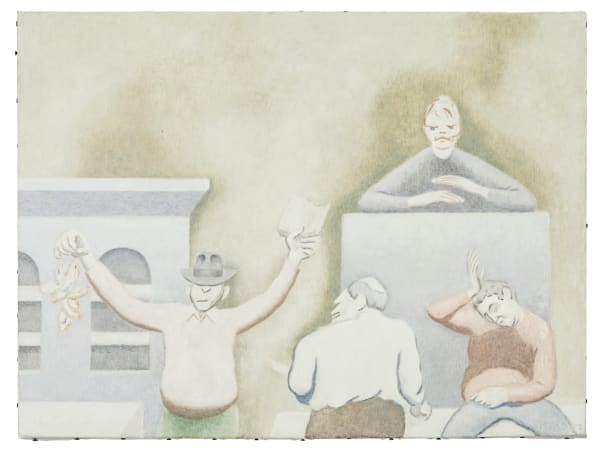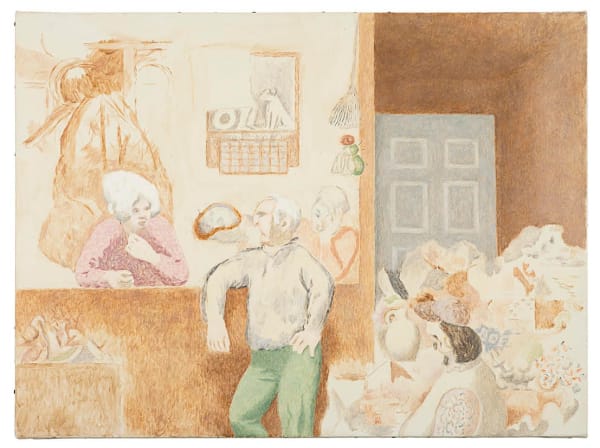David Byrd: Auction Action
|
Anton Kern Gallery is pleased to present a thematic exhibition of works by the late American artist David Byrd (1926 – 2013), focusing on depictions of live auctions. The format of the auction, with its explicit and implicit rules, roles, and theatricality, inspired numerous compositions and figure studies spanning from the 1970s to the aughts. The exhibition, presented in the gallery’s main space, includes oil paintings, pencil drawings, carved wooden sculptures, and auction cards bearing Byrd’s bidder numbers, notes, and sketches.
Byrd was a decades-long fixture at auctions in and around rural Delaware County, NY, where items for sale ranged from farm tools to babydolls, bird houses and clocks, to building materials and patent models. An active participant in this local sub-economy, Byrd was an avid collector of antique bottles and glass jars. He had a discerning eye and made supplemental income as a seller on the niche bottle show circuit. No one, including auctioneers and aficionados he interacted with for years, knew that he was an artist.
It is clear in each of the works that Byrd himself was present in the auction crowds he depicted, acutely attuned to his surroundings throughout each ceremony. Like the visual memories he carried home from work at the Montrose VA hospital, his photographic memory allowed him to create detailed renditions of auction scenes after the fact. When considered alongside his ‘Montrose’ works, the ‘auction’ works speak to Byrd’s way of relating to the world: always at a distance, the quiet observer. Across the exhibition, and particularly exemplified in the auction cards he kept, is evidence of Byrd’s compulsion to record what was happening not to him, but around him. He creates a clear delineation between himself and others, treating everyday settings like a theater.
A throughline in Byrd’s practice is his fascination with the body’s demonstrative expressions and poses. His crowds of faces resemble James Ensor masks, and their bodies are posed like Oskar Schlemmer dancers. Works such as Auction Block (1973) and Study in Brown (2008) capture the coded choreography used by auctioneers to manage bids in the room, their hands elongated and oversized. The group scene of uproarious bidders in Sketchbook 2, p.52 (n.d.) echoes the frenzy on the psychiatric ward in Byrd’s Montrose painting 3:00am (1960).
Byrd’s canny ability to reduce forms while still communicating complex emotion allows the viewer to focus on the importance of the few details that he includes in the paintings. Geometric pictorial architecture (á la his teacher Ozenfant) forms the basic set of an auction room. Clothing is simplified as if worn by dancers in leotards, drawing focus to the emotion in their faces and the peculiarities of their poses. The wooden sculptures, which he carved from apple trees on his property, are crudely made, yet succinctly capture the intended gestures (i.e.: an auctioneer engaging the crowd, a collector inspecting a bottle.)
Perhaps the most psychologically complex work in the exhibition is Byrd’s 1989 painting Scroll Flask and Hand. Here we are presented with a quasi-diagram of an auction in progress. The auctioneer looks out soliciting bids, and an immaculate hand pokes in presenting the object for sale. The ornate vessel is surrounded by a halo of light, as if it were an apparition. A woman half hidden by a wall strikes an off-duty pose, likely unaware that the audience can see her. The fourth wall is broken by the bid recorder, a young female figure in the center of the composition who looks directly out at us, in a gaze of inarticulate acknowledgement. Through the artist’s decisive embellishments and omissions, we are there with him in the front row, entranced by this magical object. |
-
 David ByrdAuction, 2007
David ByrdAuction, 2007 -
 David ByrdAuction Crowd, 1990
David ByrdAuction Crowd, 1990 -
 David ByrdSet Up Bottle Show, 1989
David ByrdSet Up Bottle Show, 1989 -
 David ByrdAuctioneer, Recorder and Assistant, 2000
David ByrdAuctioneer, Recorder and Assistant, 2000
-
 David ByrdShow at Herkimer, 2001
David ByrdShow at Herkimer, 2001 -
 David ByrdMan Receiving Bids, 2002
David ByrdMan Receiving Bids, 2002 -
 David ByrdMan With Doll, 2009
David ByrdMan With Doll, 2009 -
 David ByrdStudy in Brown, 2008
David ByrdStudy in Brown, 2008

























